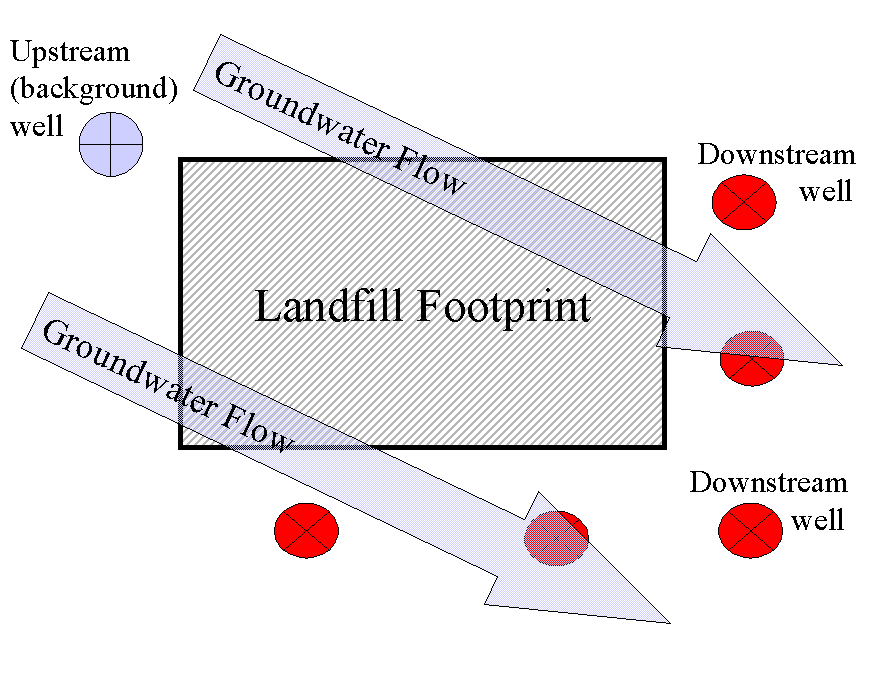Lesson
12: MSW Landfills
Monitoring, Post-Closure Care, and Misc. Topics
Monitoring Requirements
Read:
Text, Section 11-8 (pp. 460-467)
Groundwater
monitoring
Statement
of Federal Regulation:
- The requirements in this Part apply to MSWLF units, except as provided in paragraph (2) of this section.
- Ground-water monitoring requirements under 40CFR258.51 through 40CFR258.55 of this Part may be suspended by
the Director of an approved State for a MSWLF unit if the owner or operator can demonstrate that there is
no potential for migration of hazardous constituents from the MSWLF unit to the uppermost aquifer (as defined in
40CFR258.2) during the active life of the unit and the post-closure care period. This demonstration must
be certified by a qualified ground-water scientist and approved by the Director of an approved State, and must
be based upon:
- Site-specific field collected measurments, sampling, and analysis of physical, chemical and biological processes
affecting contaminant fate and transport, and
- Contaminant fate and transport predictions that maximuize contaminant migration and consider impacts on humna
health and environment.
|
Location of Groundwater Monitoring Wells
|
 |
Air
Monitoring
Explosive
gases control:
Methane is explosive when present in a range of 5 (lower explosive limit, LEL)
to 15 (upper explosive limit, UEL) percent by volume in air. Methane is not explosive when present
in concentrations greater than 15% however, fire and axphyxiation are still a threat at these levels. Also,
any dilution due to mixing with ambient air could bring the mixture back into the explosive range.
Statement of Federal Regulation:
- Owners or operators of all MSWLF units must ensure that:
- The concentration of methane gas generated by the facility does not exceed
25 percent of the lower explosive limit for methane in facility structures (excluding gas control or recovery system
components); and
- The concentration of methane gas does not exceed the LEL for methane at
the facility property boundary.
- Owners or operators of all MSWLF units must implement a routine methane
monitoring program to ensure that the standards of paragraph (1) of thes section are met.
- The type and frequency of monitoring must be determined based on the follwoing
factors:
- soil conditions;
- the hydrogeologic conditions surrounding the facility;
- the hydraulic conditions surrounding the facility; and
- the location of facility structures and property boundaries.
- The minimum frequency of monitoring shall be quarterly.
- If methane gas levels exceeding the limits specified in paragraph (1) of
this section are detected, the owner or operator must:
- Immediately take all necessary steps to ensure protection of human health
and notify the State Director;
- Within seven days of detection, place in the operating record the methane
gas levels detected and a description of the steps take to protect human health; and
- Within 60 days of detection, implement a remediation plan for the methane
gas releases, place a copy of the plan in the operating record, and notify the State Director that the plan has
been implemented. The plan shall describe the nature and extent of the problem and the proposed remedy.
- The Director of and approved State may establish alternative schedules
for demonstrating compliance.
- For purposes of this section, lower explosive limit (LEL) means the lowest
percent by volume of a mixture of explosive gases in air that will propogate a flame at 25C and atmospheric pressure.
Air Criteria:
Statement of Federal Regulation:
- Owners or operators of all MSWLFs must ensure that the units do not violate
any applicable requirements developed under a State Implementation Plan (SIP) approved or promulgated by the Administrator
pursuant to section 110 of the Clean Air Act, as amended.
- Open burning of solid waste, except for the infrequent burning of agricultural
wastes, silvicultural wastes, land-clearing debris, diseased trees, or debris from emergency clean-up operations,
is prohibited at all MSWLF units.
Air criteria requirements are becoming a bigger issue for landfills as the
control of green-house gases becomes more of a priority. Both CH4 and CO2
are green-house gases. CH4
is 10x more potent than CO2.
A potential benefit of aerobic
landfilling is a reduction in the CH4
emissions however, aerobic
processes produce NOX
another green-house gas which is more difficult to treat than methane. Landfill gas flares convert CH4 to CO2 and H2O.
Post-closure Care
Read: Text,
Section 11-11 (pp. 490-491)
Miscellaneous topics
Read: A
Superior Approach to Leachate Recirculation
Page
last updated April 23, 2015 by Dr.
McCreanor

